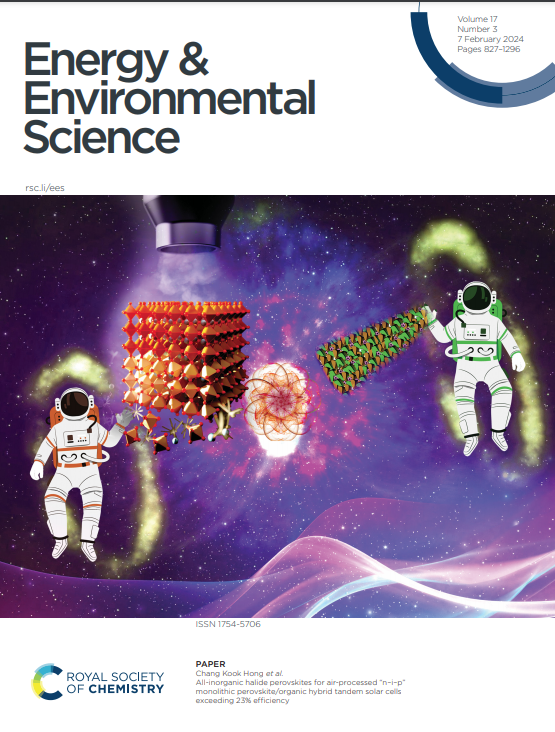Multifunctional zeolite film enables stable high-voltage operation of LiCoO2 cathode
IF 32.4
1区 材料科学
Q1 CHEMISTRY, MULTIDISCIPLINARY
引用次数: 0
Abstract
Increasing upper cut-off voltage is a useful way for enhancing specific capacity of LiCoO2 (LCO) cathode and the energy density of corresponding lithium-ion batteries (LIBs), while the main challenge is concurrent phase transition associated with oxygen evolution reaction that results in quick decay in electrochemical performance. Here, we report a significant improvement in both capacity and durability at high voltage by simply growing an AlPO4-5 zeolite protecting layer over LCO, with good crystallinity, ordered porous channels and full surface coverage. Such coating, realized by using triethylamine as a template, acts multifunctionally to remarkably alleviative phase transition via suppressing the oxygen release at high voltage, enable fast Li+ diffusion through its nanoporous structure, accelerate the Li+-desolvation on the cathode/electrolyte interface, and boost the redox kinetics, as supported by various in-situ and ex-situ measurements of LCO@AlPO4-5 zeolite (LCO@Z) cathode under a high cut-off voltage of 4.6 V (vs. Li/Li+) and density functional theory (DFT) calculations. As a result, the surface engineered LCO@Z electrode exhibits outstanding cycling stability (capacity retention of 90.3% after 200 cycles) and high-rate capability (108.2 mAh g-1 at 10C). Such zeolite coating strategy provides a new way for developing high-energy-density LIBs with great application potential.多功能沸石薄膜实现了钴酸锂阴极的稳定高压运行
提高上限截止电压是提高钴酸锂(LCO)正极比容量和相应锂离子电池(LIB)能量密度的有效方法,而主要挑战在于与氧进化反应相关的并发相变会导致电化学性能快速衰减。在此,我们报告了通过在 LCO 上简单地生长具有良好结晶性、有序多孔通道和全表面覆盖的 AlPO4-5 沸石保护层,在高电压下显著提高了容量和耐用性。这种涂层是以三乙胺为模板实现的,具有多重功能,可通过抑制高电压下的氧释放来显著缓解相变,使 Li+ 通过其纳米多孔结构快速扩散,加速阴极/电解质界面上的 Li+ 脱溶,并提高氧化还原动力学,这一点在 LCO@AlPO4-5 沸石(LCO@Z)阴极在 4.6 V(相对于 Li/Li+)和密度泛函理论(DFT)计算。结果表明,表面工程 LCO@Z 电极具有出色的循环稳定性(200 次循环后容量保持率为 90.3%)和高速率能力(10C 时 108.2 mAh g-1)。这种沸石涂层策略为开发具有巨大应用潜力的高能量密度 LIB 提供了一条新途径。
本文章由计算机程序翻译,如有差异,请以英文原文为准。
求助全文
约1分钟内获得全文
求助全文
来源期刊

Energy & Environmental Science
化学-工程:化工
CiteScore
50.50
自引率
2.20%
发文量
349
审稿时长
2.2 months
期刊介绍:
Energy & Environmental Science, a peer-reviewed scientific journal, publishes original research and review articles covering interdisciplinary topics in the (bio)chemical and (bio)physical sciences, as well as chemical engineering disciplines. Published monthly by the Royal Society of Chemistry (RSC), a not-for-profit publisher, Energy & Environmental Science is recognized as a leading journal. It boasts an impressive impact factor of 8.500 as of 2009, ranking 8th among 140 journals in the category "Chemistry, Multidisciplinary," second among 71 journals in "Energy & Fuels," second among 128 journals in "Engineering, Chemical," and first among 181 scientific journals in "Environmental Sciences."
Energy & Environmental Science publishes various types of articles, including Research Papers (original scientific work), Review Articles, Perspectives, and Minireviews (feature review-type articles of broad interest), Communications (original scientific work of an urgent nature), Opinions (personal, often speculative viewpoints or hypotheses on current topics), and Analysis Articles (in-depth examination of energy-related issues).
 求助内容:
求助内容: 应助结果提醒方式:
应助结果提醒方式:


